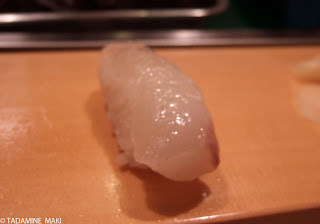Sushi part1
I have an excuse. These photos were not taken in Kyoto but in Tokyo. I uploaded these photos because Kyoto has been the capital of the traditional Japanese culture and Sushi is also the typical traditional Japanese cusine, though sushi is more popular in Tokyo than in Kyoto.
Anyway, I will add a small comment on each of 12 pieces of sushi in the Omakase, meaning 'recommendation', set menu at Sushi Dai,(here is the photo of the restaurant). The menu partly changes up to the seasons because the fish we can catch and eat differs with the season.
Well, the first sushi in this menu is a small piece of rolled egg and no vinegared rice ball. Unfortunately, there is no photo. Excuse me! The egg might be added with sugar, salt and perhaps sweet cooking rice wine, Mirin in Japanese. By the way, some epicureans says that if the egg served at a sushi restaurant is delicious, most of the restaurants are better. So the egg is thought to be a sort of important item for making a decision whether or not the sushi bar is better before they eat all the pieces of sushi. The egg seems just like butter added by bread in French restaurant or grissini in Italian restaurant.

The second sushi is Chu-toro, medium fatty tuna, which is the queen of the sushi and one of the most popular of all sushi items. This is not too rich but succulent.

The third is Mako-garei in Japanese, just like flounder, or flatfish, Hirame in Japanese. Hirame might be rather familiar to European people. The fish is one of the most popular fish with white flesh. At this bar, on the sliced flatfish are added a small amount of rock salt from Bolivia and a drop of juice from some citrus fruit. This fish is little fat and goes well with the salt and citrus juice very much.

The fourth is Uni, sea egg. The one at the bar is more creamy and sweeter than usual and rather red. This red Uni is, I suppose, called Ezobasun-Uni and one of first grade Unis, and we can eat it from spring to summer. We usually eat the orange one more than the red because the red one is precious and rare.
The rest is tomorrow...




3 Comments:
Oooooo I want that chu-toro!
Very informative post!
The papers in the States are full of stories how the tuna shortage ( restricted fishing) will affect Japanese. Do you see any problems already (higher prices, for example)?
Thanks for the comments!
keropok,
I like chutoro, too. By the way, when I was in Singapore, I go to the fish market, located just along the sea, very early in the morning. Unfortunately, I had not seen tuna. Can you eat tsutoro in your country?
isabella,
As you know, the price of tuna is rising very much in Japan and we will eat them so often. But the price of tuna sushi is not so rising at many sushi shops. But in the near future, it will be up, I suppose. Some newspaper said that the price goes up partly because tuna is becoming very popular with many country all over the world.
I don't worry about this so much because there are other delicious fish in Japan.
Post a Comment
<< Home